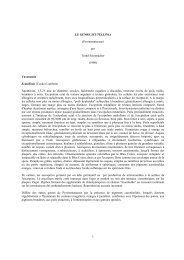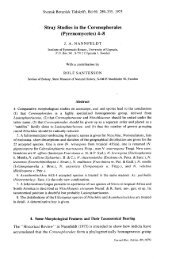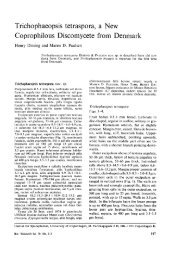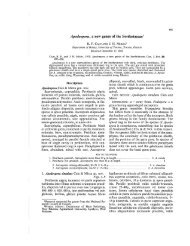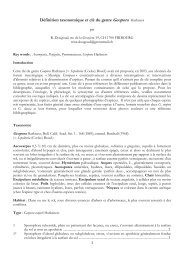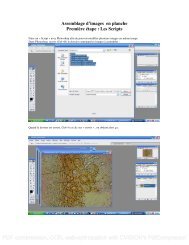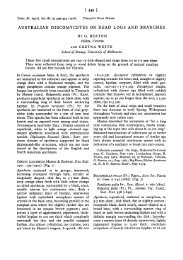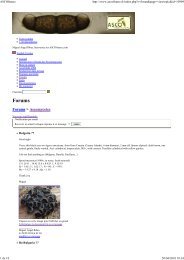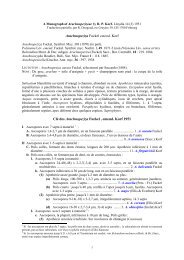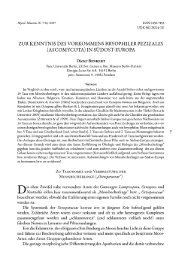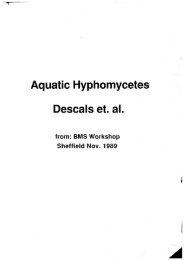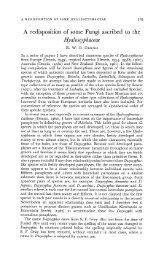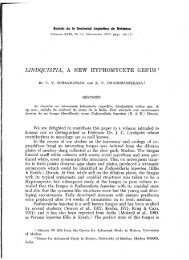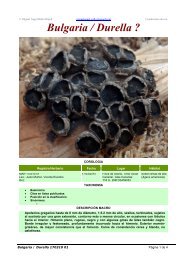Notes on British species of Geopora - ASCOfrance
Notes on British species of Geopora - ASCOfrance
Notes on British species of Geopora - ASCOfrance
Create successful ePaper yourself
Turn your PDF publications into a flip-book with our unique Google optimized e-Paper software.
<strong>British</strong> <strong>Geopora</strong> 74<br />
Sepultaria tenuis (Fuckel) Boud., Ic<strong>on</strong>. Mycol, Liste Prelim.: (3)<br />
[without paginati<strong>on</strong>] (1904).<br />
The lectotype <strong>of</strong> this <strong>species</strong> designated by Schumacher<br />
(1979) is in fact the holotype as <strong>on</strong>ly <strong>on</strong>e collecti<strong>on</strong> ('F. rh.<br />
2289') was menti<strong>on</strong>ed in the protologue. The c<strong>on</strong>cept <strong>of</strong><br />
Dennis (1960, 1978) for this <strong>species</strong> is followed here but with<br />
l<strong>on</strong>ger apothecial hairs than those described from the type<br />
(Schumacher, 1979). The example <strong>of</strong> Fuckel's Fungi Rhenani<br />
No. 2289 in K is exhausted and no other authentic material <strong>of</strong><br />
this <strong>species</strong> has been seen by the present authors.<br />
Sepultaria arenicola var. bloxamii (Cooke) Boud., Hist.<br />
Classific. Discomyc. Europe: 59 (1907).<br />
Peziza arenosa var. bloxamii Cooke, Mycographia 1: 68, Fig.<br />
121 (1876) [as 'bloxami'}.<br />
Lachnea arenicola var. bloxamii (Cooke) W. Phillips, Man. Brit.<br />
Discomyc: 211 (1887) [as:•''bloxami').<br />
Examinati<strong>on</strong> <strong>of</strong> the type <strong>of</strong> this tax<strong>on</strong> labelled ' Peziza sepulta,<br />
Liverpool' in K shows it to have ellipsoid to el<strong>on</strong>gate-ellipsoid<br />
ascospores 22-0-25-5(-27-0) x 13-0-15-0 pm. We agree with<br />
Massee (1895) that this is a syn<strong>on</strong>ym <strong>of</strong> G. arenicola.<br />
Boudier (1907) referred his combinati<strong>on</strong> to Cooke's<br />
Mycographia Fig. 121, but also err<strong>on</strong>eously to Saccardo's Syll.<br />
Fung. 11: 393, where Geopyxis bloxamii [as 'bloxami'} Massee<br />
(Grevillea 22: 98, 1894) was listed. Massee's <strong>species</strong>, from<br />
Oxford (Baxter), <strong>on</strong> the ground, was described without any<br />
c<strong>on</strong>necti<strong>on</strong> with Cooke's fungus which was from near<br />
Liverpool, am<strong>on</strong>gst sand.<br />
Sepultaria geaster (Berk. & Broome) Boud., Hist. Class.<br />
Discomyc. Europe: 59 (1907).<br />
Peziza geaster Berk. & Broome in Ann. Mag. Nat. Hist. Ser. 3,<br />
7: 449 (1861), n<strong>on</strong> Rabenhorst (1867).<br />
Lachnea geaster (Berk. & Broome) W. Phillips, Man. Brit.<br />
Discomyc: 210 (1887).<br />
The holotype material, labelled as 'Peziza geaster B. & B.,<br />
Wentworth, Oct. 9 1858', in K, displays ellipsoid to<br />
el<strong>on</strong>gate ellipsoid ascospores 22-0—25-5 x 13-0—14-5 pm, and<br />
represents G. arenicola. We agree with Lundell & Nannfeldt<br />
(1941) and with Kers (1974), who treated P. geaster as a<br />
syn<strong>on</strong>ym <strong>of</strong> G. arenicola. It may be noted that this tax<strong>on</strong> was<br />
published as a new <strong>species</strong> twice by the same authors<br />
(Berkeley & Broome, 1861, 1866).<br />
Sepultaria semiimmersa (P. Karst.) Massee, Brit. Fung. -F/.4:<br />
391 (1895).<br />
Peziza semiimmersa P. Karst., Not. Fauna Fl. Fenn. 10: 117<br />
(1869).<br />
Humaria semiimmersa (P. Karst.) Sacc, Syll. Fung. 8: 143<br />
(1889).<br />
Leucoscypha semiimmersa (P. Karst.) Svrcek in Ceskd Mykol 28:<br />
133 (1974).<br />
Octospora semiimmersa (P. Karst.) K. B. Khare & V. P. Tewari in<br />
Can. J. Bot. 56: 2118 (21 Sept. 1978).<br />
Octospora semiimmersa (P. Karst.) S. Ahmad, M<strong>on</strong>ogr. Biol. Soc.<br />
Pakistan 7: 183 (1978).<br />
(Accepted 24 June 1995)<br />
Byss<strong>on</strong>ectria semiimmersa (P. Karst.) Benkert in Gledilschia 15:<br />
181 (1987).<br />
This is a reddish <strong>species</strong>, out <strong>of</strong> place in <strong>Geopora</strong>. It appears to<br />
be c<strong>on</strong>generic with Peziza patavina Cooke, and further<br />
investigati<strong>on</strong> is required to establish an appropriate generic<br />
placement for these two <strong>species</strong>.<br />
We thank R. K. Brummitt (Royal Botanic Gardens, Kew) for<br />
nomenclatural discussi<strong>on</strong>s and Pr<strong>of</strong>essor D. L. Hawksworth<br />
(Internati<strong>on</strong>al Mycological Institute, Egham) for general<br />
comments <strong>on</strong> the manuscript. This work is supported by a<br />
grant (GR3/8284) from the Natural Envir<strong>on</strong>ment Research<br />
Council for the project 'The Ascomycetes <strong>of</strong> Great Britain and<br />
Ireland'.<br />
REFERENCES<br />
Ahmad, S. (1978). Ascomycetes <strong>of</strong> Pakistan, Part I. Biological Society <strong>of</strong> Pakistan<br />
M<strong>on</strong>ograph No. 7. Biological Society <strong>of</strong> Pakistan: Lahore, Pakistan.<br />
Berkeley, M. J. (1866). On two new <strong>British</strong> fungi. Transacti<strong>on</strong>s <strong>of</strong> the Linnean<br />
Society 25, 431-432.<br />
Berkeley, M. J. & Broome, C. E. (1861). Notices <strong>of</strong> <strong>British</strong> fungi. The Annals<br />
and Magazine <strong>of</strong> Natural History 7, 449-456.<br />
Berkeley, M. J. & Broome, C. E. (1866). Notices <strong>of</strong> <strong>British</strong> fungi. The Annals<br />
and Magazine <strong>of</strong> Natural History 18, 121-129.<br />
Boudier, E. (1904). Ic<strong>on</strong>es Mycologicae. Ser. 1, Livr. 2. Librairie des Sciences<br />
Naturelles, Paul Klincksieck: Paris.<br />
Boudier, E. (1907). Histoire et Classificati<strong>on</strong> des Discomycetes d'Europe. Librarie<br />
des Sciences Naturelles, Klincksieck: Paris.<br />
Cann<strong>on</strong>, P. F., Hawksworth, D. L. & Sherwood-Pike, M. A. (1985). The <strong>British</strong><br />
Ascomycotina, an annotated checklist. Comm<strong>on</strong>wealth Agricultural Bureaux:<br />
Slough, U.K.<br />
Cooke, M. C. (1876). Mycographia, seu Ic<strong>on</strong>es Fungorum. Williams & Norgate:<br />
L<strong>on</strong>d<strong>on</strong>. 1, 45-86.<br />
Cooke, M. C. (1877). Mycographia, seu Ic<strong>on</strong>es Fungorum. Williams & Norgate:<br />
L<strong>on</strong>d<strong>on</strong>. 1, 137-178.<br />
De La Torre, M. (1975). Estudio sobre Discomycetes operculados: clave y<br />
generos nuevos para la flora Espanola Peninsular. Instituto Botanico Ant<strong>on</strong>io<br />
Jose Cavanilles 32, 85-101.<br />
Dennis, R. W. G. (1960). <strong>British</strong> Cup Fungi and their Allies, An introducti<strong>on</strong> to<br />
the Ascomycetes. Ray Society: L<strong>on</strong>d<strong>on</strong>.<br />
Dennis, R. W. G. (1978). <strong>British</strong> Ascomycetes, 2nd ed. ]. Cramer: Vaduz,<br />
Germany.<br />
Fuckel, L. (1865). Fungi Rhenani exsiccati. Cent. 12-17, No. 1101-1700.<br />
Fuckel, L. (1866). Fungi Rhenani exsiccati. Cent. 12-17, No. 1101-1700.<br />
Hedwigia 5: 14-16.<br />
Greuter, W., Barrie, F. R., Burdet, H. M„ Chal<strong>on</strong>er, W. G„ Demoulin, V.,<br />
Hawksworth, D. L., Jorgensen, P. M., Nicols<strong>on</strong>, D. H., Silva, P. C, Trehane,<br />
P. & Mcneill, J. (1994). Internati<strong>on</strong>al Code <strong>of</strong> Botanical Nomenclature. Koeltz<br />
Scientific Books: K<strong>on</strong>igstein, Germany.<br />
Kers, L. E. (1974). The Swedish <strong>Geopora</strong>e and their Pyrenomycete infecti<strong>on</strong>s.<br />
Svensk Botanisk Tidskrift 68, 344-354.<br />
Lundell, S. & Nannfeldt, J. A. (1941). Fungi exsiccati Suecici, praesertim<br />
Upsalienses, Fasc. XIX-XX.<br />
Massee, G. (1895). <strong>British</strong> Fungus Flora. A Classified Text-book <strong>of</strong> Mycology, Vol.<br />
4. George Bell & S<strong>on</strong>s: L<strong>on</strong>d<strong>on</strong>.<br />
Moreno, G., Galan, R. & Ortega, A. (1986). Hypogeous fungi from<br />
c<strong>on</strong>tinental Spain. I. Cryptogamie Mycologie 7, 201-229.<br />
Phillips, W. (1887). A Manual <strong>of</strong> the <strong>British</strong> Discomycetes. Kegan Paul, Trench &<br />
Co: L<strong>on</strong>d<strong>on</strong>.<br />
Saccardo, P. A. (1889). Sylloge Fungorum, Vol. 8. Sacccardo: Patavia.<br />
Schumacher, T. (1979). <str<strong>on</strong>g>Notes</str<strong>on</strong>g> <strong>on</strong> tax<strong>on</strong>omy, ecology, and distributi<strong>on</strong> <strong>of</strong><br />
operculate discomycetes (Pezizales) from river banks in Norway. Norwegian<br />
Journal <strong>of</strong> Botany 26, 53-83.<br />
Seaver, F. J. (1928). The North American Cup-fungi (Operculates). Seaver: New<br />
York.<br />
Zhang, B.-C. & Yu, Y.-N. (1992). Revisi<strong>on</strong> <strong>of</strong> Chinese <strong>species</strong> <strong>of</strong> <strong>Geopora</strong><br />
(Pezizales). Acta Mycologia Sinica 11, 8-14.



